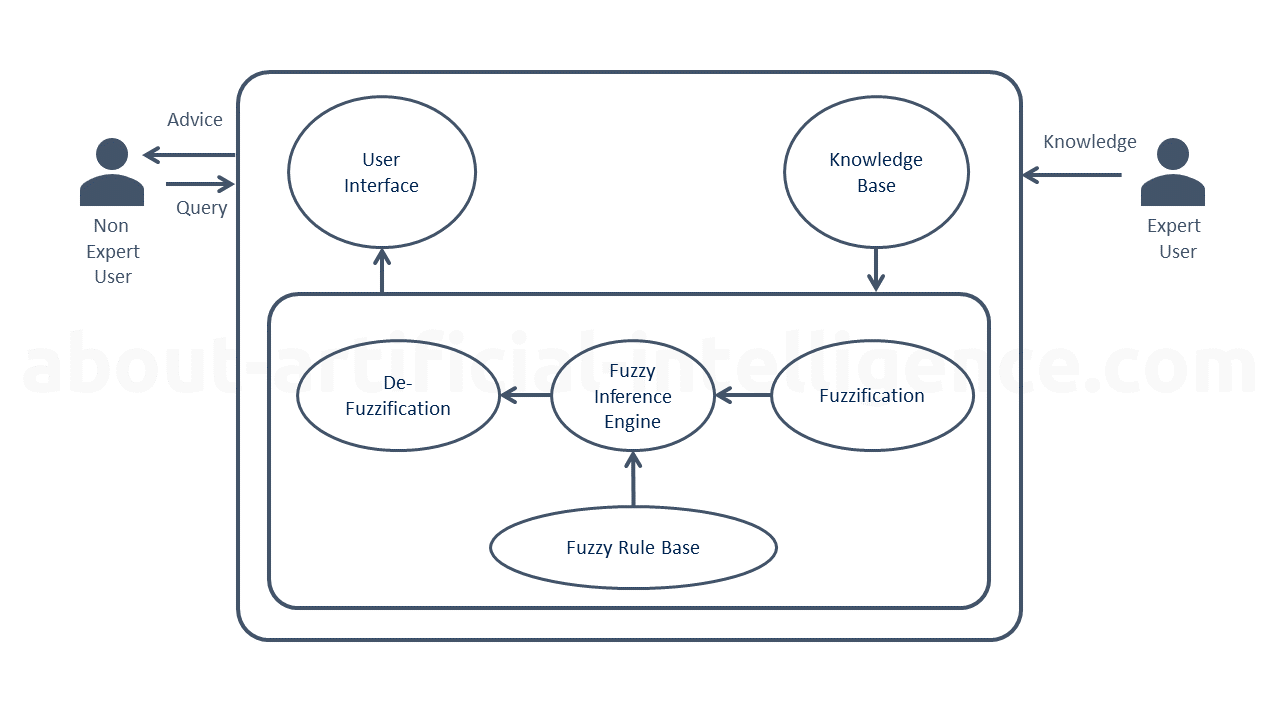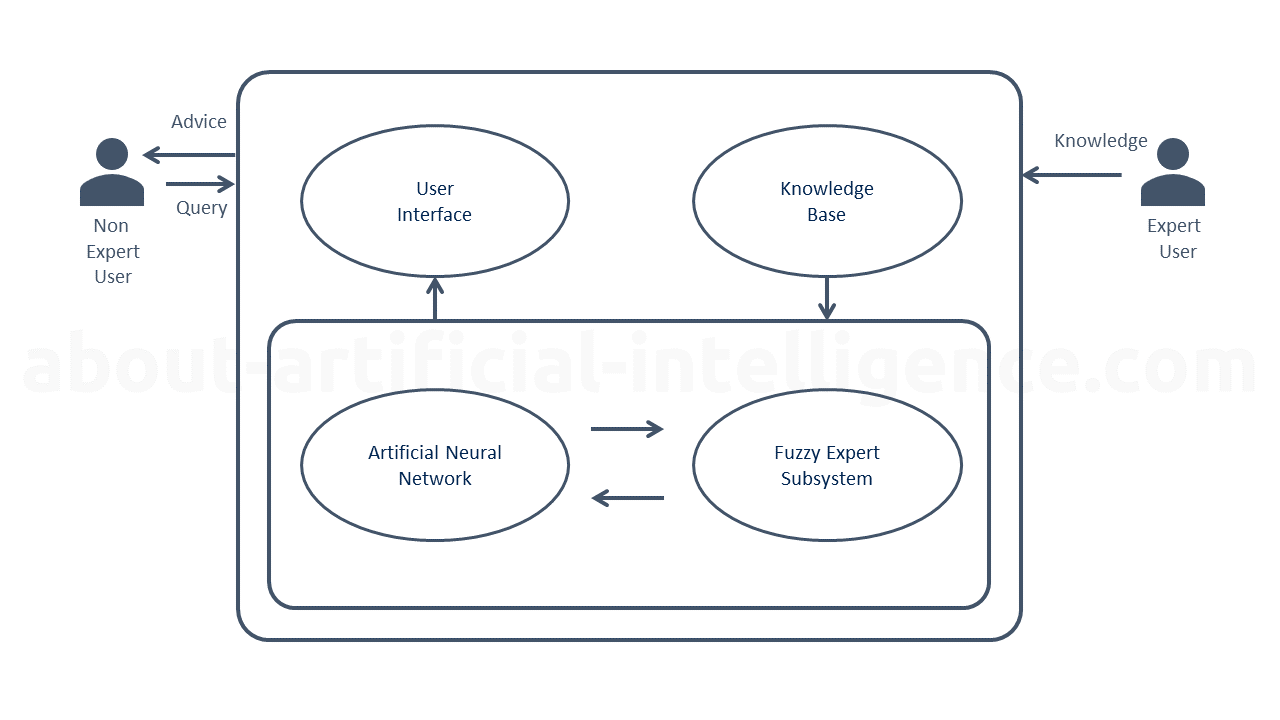Types of Expert Systems
Expert systems exist in different types. Rule-based expert systems, fuzzy expert systems and frame- based expert systems are examples of expert systems types. The term "hybrid expert system" refers to a system that combines two or more types of expert systems. Roughly speaking, the expert systems can be divided into the following types.
Rule Based Expert Systems
Rule-based expert systems are, as the name suggests, based on a set of rules. Rules are a dynamic, expressive, and straightforward way to express knowledge. The knowledge of a rule-based expert system is represented as a set of rules. A theoretical or practical understanding of a topic or domain is called knowledge. Experts have accumulated a lot of information and practical experience over time, which leads to expertise. Experts have the ability to encode knowledge in the form of rules. Each rule consists of two parts: the IF part, also called the antecedent (premise or condition), and the THEN part, often called the consequence (conclusion or action). The basic syntax, often referred to as the rule base, is as follows:
Example:
In this rule, the object is temperature and humidity, and the value is 30°C and 70%, respectively. The operator is ">" (greater than). The consequence is to implement a cooling system.
Several antecedents can be connected by the keywords AND, OR or a mixture of both in a rule. The prototype of a rule consists of two parts. They are the object and the value of the object. An operator connects the object to the value. The operator can be logical or mathematical.
Rule-based expert systems are advantageous because they are easy to create, maintain and modify. They can be used to represent a wide range of knowledge, from simple decision-making to complex problem-solving. They are also relatively easy to explain and understand. However, rule-based expert systems are limited because they lack the ability to learn, which makes them less sophisticated than other AI systems.
Examples of rule-based expert systems include the Mycin system (an antibiotic selection system) and the DENDRAL system (a system to identify chemical compounds). These systems use inference rules to determine the best course of action or decision to solve a problem. They use the IF-THEN structure to store and retrieve knowledge. The knowledge is represented in the form of rules and facts, and the inference engine processes the rules and facts to reach a conclusion.
Fuzzy Expert Systems
As humans, we face numerous situations every day in which we cannot accurately determine whether a condition is true or false. To simplify the distinction between true and false situations, fuzzy logic can be used. Fuzzy logic has a high degree of flexibility in reasoning. This flexibility drastically reduces the confusion and errors.
Fuzzy logic, unlike classical logic, is a type of logic used to describe fuzziness. Fuzzy logic can be considered as a branch of mathematics in which the concept of fuzziness is defined in detail. A basic idea of classical logic is that there are only two truth values: False (0) and True (1). In fuzzy logic, all truth values are expressed as real integers ranging from 0 (completely false) to 1 (completely true), and in this way the probability that a given statement is true or false is represented by a number in the interval 0 to 1. However, the most important question that remains unanswered in the context of fuzzy logic is how to distinguish between members of a class and those that do not belong to this class. Fuzzy logic allows us to distinguish between members and non- members of classes, since we assume that everything is characterized on a sliding scale that allows us to distinguish between them. This means that the boundaries of classification are not as clear as in non-fuzzy systems. The following diagram shows the typical architecture of a fuzzy expert system.
In simple words, it is a generalization of classical logic, in which the degree of truth of an idea lies between 0.0 and 1.0. Standard logic assigns a value of 1.0 to completely true concepts and a value of 0.0 to completely false concepts. In fuzzy logic, however, there is an intermediate value that is both true and false. For example, in fuzzy logic there can be a case that 0.4 is False which means it is 0.6 True.
You can use fuzzy logic to describe confusing data by calculating the degree of validity of a hypothesis, a method known as fuzzy reasoning. Fuzzy logic can also be used to reason about concepts that are inherently confusing , i.e., there is no clear rightness or wrongness. Fuzzy logic is a flexible and effective framework for conceptual simulation of human reasoning that uses machine learning techniques to simulate human reasoning in a logical manner.
In the fuzzy expert system, knowledge can be described using fuzzy set theory. For example, we can define the words such as "slightly increased", " slightly decreased", "moderately hard", "not so old" and "very large" in the system.

@fig:architecture-of-a-fuzzy-expert-system
In other words, in the fuzzy expert system, knowledge is represented using fuzzy rules which describe the relationships between input and output variables. Fuzzy rules consist of conditions and consequences which are expressed as fuzzy sets. The fuzzy sets are used to represent the conditions and the consequent is expressed as a fuzzy set. The fuzzy rules are then used to draw conclusions based on the input data. The fuzzy expert system then uses fuzzy inference, which is the process of combining the fuzzy rules to arrive at a conclusion. The fuzzy inference process is based on fuzzy logic operations such as AND, OR, NOT and IF-THEN rules. The fuzzy inference process allows the system to make decisions based on the input data and the fuzzy rules.
Frame Based Expert Systems
In a frame-based expert system, knowledge is represented by frames, which are utilized to represent the knowledge. As the name implies, a frame is a data structure that holds detailed information about a certain item or concept. Each frame has a unique name as well as a unique set of characteristics. It is possible to describe knowledge in a systematic and concise manner using a frame. Roughly speaking, frames are an example of object-oriented programming being used in the context of expert systems. When compared to rule bases, the advantage of frames is that we only need to search frames in order to execute rules, but a rule-based expert system must search all rules in order to execute them.
A frame-based expert system can be used to collect, store, and organize data in an efficient and organized manner. This makes it much easier to access, analyze, and manipulate the data since all the relevant knowledge is already organized and stored in frames. Additionally, frames allow the system to represent knowledge in a much more intuitive and organized way. This makes it easier to identify relationships between different pieces of knowledge, and the system can then use this information to make better decisions. Compared to a rule-based system, a frame-based system is more efficient and user-friendly.
The main advantage of using a frame-based expert system is that it provides a structure for representing knowledge and information. By using a frame-based system, the system is able to represent the knowledge in an organized and structured way. This makes it easier to store, access, and manipulate the data. Additionally, frames allow the system to represent knowledge in a more intuitive manner, which allows it to identify relationships between different pieces of knowledge and use this information to make better decisions. This makes it easier for users to understand the system and its decisions. Finally, a frame-based system is more efficient than a rule-based system, making it a more attractive option for expert systems.
Neural Expert Systems
The term "neural expert system" refers to a hybrid expert system that contains both a neural network and a rule-based expert system. This is an attempt to enable better decision making. This hybrid concept is also known as a connectionist expert system. The advantages of this approach is to combine learning, generalization, resilience and parallel information processing of rule-based expert systems with neural networks to form a hybrid system.
The neural expert system is a type of artificial intelligence that combines the learning capabilities of a neural network with the logical capabilities of a rule-based expert system. The neural network can be used to detect patterns in data and make predictions, while the expert system can be used to evaluate the accuracy of the neural network’s predictions. This allows the system to make decisions that are more accurate than those made using either technology alone. In addition, the hybrid system is able to adapt to changes in the environment and adjust its decisions accordingly. This makes it useful for applications where the decision making process must be constantly updated.
The main benefit of neural expert systems is that they can provide more accurate and reliable decisions than traditional expert systems. Furthermore, the system is able to cope with changing environmental conditions and adapt to new data. This makes it suitable for applications such as medical diagnostics and fraud detection, which are particularly dynamic. Additionally, the hybrid system can be used in applications where the decision making process is too complex or time consuming for a human to accurately carry out.
Overall, the neural expert system is a powerful hybrid artificial intelligence system that combines the best features of both neural networks and rule-based expert systems. This allows it to make more accurate and reliable decisions than either technology alone and to adapt to changing environmental conditions. It is therefore well suited for applications where the decision making process is too complex or time consuming for a human to accurately carry out.
Neuro-Fuzzy expert systems
Fuzzy logic and neural networks are natural complements in the creation of intelligent systems. Their combination can work well together. While neural networks are a low-level computer framework that is defined by the processing of raw data, fuzzy logic is a higher-level reasoning framework that is based on language input gathered from experts and used to make decisions. Although neural networks are capable of learning, they remain inaccessible to the user, resulting in a "black box" experience for the end user. On the other hand, fuzzy systems that are not capable of learning and adapting to a new environment, are able to communicate and underestood by the user. An expert system that is generated using a neural network and a fuzzy expert system is created when these two techniques are merged. Roughly speaking, neural networks have good learning ability, and in fuzzy systems we can represent and distinguish the knowledge well. Neuro-fuzzy systems combine the capabilities of neural networks and fuzzy systems. As a result of this combination, the neural network become more transparent, and the fuzzy system become learnable. In other words, a neuro- fuzzy system is a neural network that can be used for fuzzy inferencing. It is also called a neuro- fuzzy network. We can train a neuro-fuzzy network so that it creates IF-THEN fuzzy rules based on the input and output variables of the system (Negnevitsky, 2011). The following diagram shows a simplified architecture of a neuro-fuzzy expert system.

@fig:architecture-of-a-neuro-fuzzy-expert-system
The fuzzy logic system provides a framework that can be used to understand input in terms of linguistic variables, whereas the neural network can be used to learn and optimize the system's performance. This combination results in a powerful system that is capable of flexibility, accuracy and understanding. It can be used to make decisions that are more accurate and reliable than either of the systems used alone. Furthermore, the combination of the two systems allows for the integration of both the human expert's knowledge and the machine's ability to learn and adapt. This allows for a system that is able to make decisions based on both data and expert opinion, maximizing the chances of success.